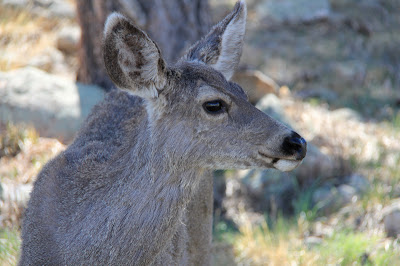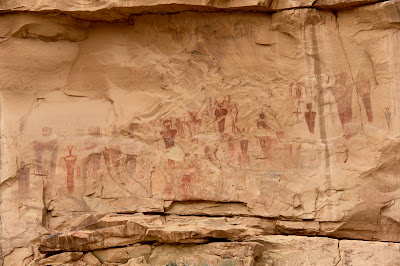Distance: 3 miles round trip
Elevation: 6,143 ft - 7,251 ft
Elevation Gain: 1,108 ft
Dogs: On leash
Bathroom at Trailhead: Yes
 |
| Bridal Veil Falls form the backdrop of mysterious Hanging Lake |
Hanging Lake is a mysterious destination tucked into a crenelation of Glenwood Canyon near the town of Glenwood Springs. It is mysterious for the aqua and teal color of its waters and for the tropical feel of the two water falls that form its backdrop. It is also mysterious because it is not easy to get to. For anyone who has driven through Glenwood Canyon, you know about the two elevated highways that weave around and across the Colorado River. Because of this, there is only one way to the trailhead, and that is from the east bound span. After your hike, it is necessary to travel ALL THE WAY back to Glenwood Springs to head east again if that is the direction you need to go. A similar frustrating round-a-bout is necessary if you are traveling west. You have to travel to Glenwood Springs and then turn around and travel back east to the trailhead. This destination is so cool, however, that you really won't care that much.
 |
| The rest area with its bathroom |
 |
| Starting out on the bike trail |
The trailhead is accessed from the Hanging Lake Rest Area with its picnic tables and restroom. The trailhead is 0.25 miles up the Glenwood Canyon bike path, which travels the entire length of the canyon (12.5 miles). The trailhead if obvious. There is a bike ride and large trailhead sigh, which warns hikers of the strenuous nature of the trail. It is 1.2 miles from here to the lake.
 |
| Moon next to one of the towers of Glenwood Canyon. Note the layers of sedimentary rock in the lower right. Glenwood Canyon was formed by the Colorado River cutting through layers of Pennsylvanian and Mississippian Sandstone. |
 |
| The Colorado River. I really want to ride the 12.5 mile bike that that travels through the canyon. Last year (2011) it was closed due to high water. |
The trail to Hanging Lake IS steep, but is certainly no worse than
Boulder's Royal Arch or Saddle Rock trails. Almost anyone with some level of fitness and a full day to spend can make it to the lake. Dawdling is for Texans however. Coloradans should bag the scenic nature of the trail, grab a defibrillator, and hustle up the trail as fast as possible. You can gaze at pleasant Dead Horse Creek and looming rock walls on the way down. Maximum burn and cardiovascular distress should be your goal on the way up. Since I was on my way back from
Arches National Park and did not bother to bring any water with me, this was my plan. I definitely smoked the numerous families and occasional grand ma mas that littered the trail like beer cans after the Sturgis Bike Rally. Hanging Lake may be mysterious but it is certainly not undiscovered.
 |
| The early part of the trail is exposed and traverses a large tallus pile. |
 |
| The trail follows pleasant Dead Horse Creek. Several bridges take the hiker back and forth across it. |
Most of the trail is rock steps with a few bridges that traverse the creek. After 1.1 miles, a tall, precipitous staircase takes the hiker the last 50 vertical feet to the lake. If you are not freaking out over the drop off, take a second to admire the view of the canyon walls. The geology of Glenwood Canyon is a wonder of Colorado. I for one was gasping and grasping at the handrail, having forgotten this short but nerve-wracking pitch. The ascent takes seconds, blessed be, and then you are at the lake.
 |
| Much of the trail is in the trees |
 |
| A small shelter hugs one wall of the canyon |
A nice Trex deck with equally pleasant benches lines the lake so you can gaze at the pond scum that lines the border. What eery denizens live in these wildly colorful waters? Stay at the lake after dark and you may find out the hard way!
 |
| A more manicured trail segment |
There is a large log that bisects the lake and in my short time there I saw more than one crazy tourist try to walk out on it. While certainly damaging to the psyche, a fall into Hanging Lake is more likely to affect the local critters so please be kind to the green slime that really doesn't want to be bathed in human excretions.
 |
| The view of the Dead Horse Canyon from the stairs |
 |
| Heading up the narrow, rough cut steps |
I did see people climbing up above the waterfalls, so there is a route up there, but I was in a rush, so I did not try to find it It was actually cold the day I did this hike, and breeze became colder after blowing across the water. So don't let the tropical ambiance fool you. This destination can be nippy so plan accordingly.
 |
| "Pond Scum" adds to the colorful nature of Hanging Lake |
 |
| The right side of the lake is dirt. Note the Trex deck along the far edge. |
The shelf holding the lake against the walls is formed by Travertine, a limestone deposit that is known to form shelves near hot springs (think Yellow Stone National Park or Havasupai Falls). It is extremely fragile, which is why the deck was built and tourists are asked not to enter the water.
 |
| Heading back down the steep staircase. Those handrails come in handy. |
Hanging Lake is one of the 100 classic hikes of Colorado. In 2011 it was made a Natural Natural Landmark. Don't pass this up if you are in the area.
























































